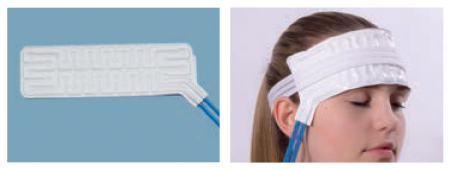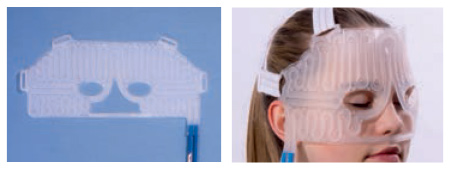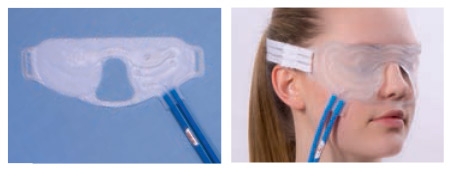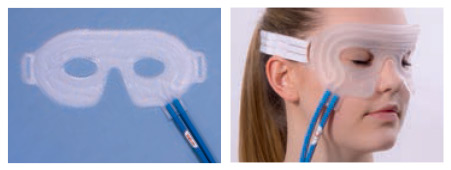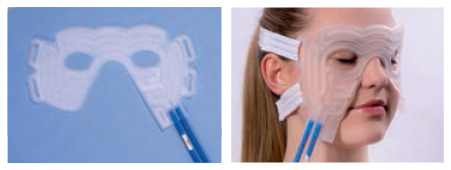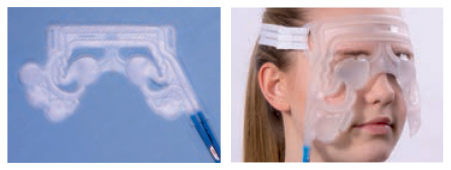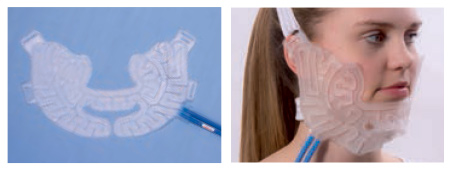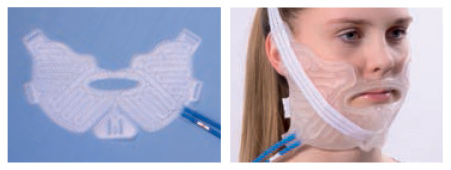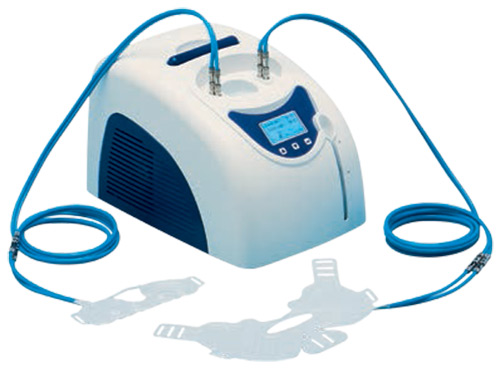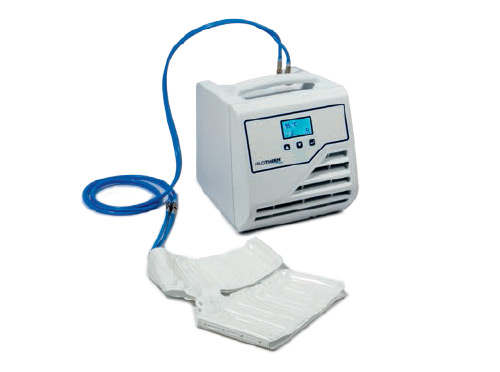for Maxillofacial Surgery
Research and Studies | Testimonials | Treatment Cuffs
Post-operative pain reduction: meta-analysis of hilotherapy versus conventional facial coolingDr Anthony Bates, Mr Greg J Knepil (2014) Introduction Craniofacial surgery causes post-operative pain and impaired neurological scores. Regional cooling using Ice or cold water reportedly improves these outcomes. Hilotherapy delivers cooled water to the skin via an anatomically designed face mask at 15°C. A meta-analysis of Hilotherapy for post operative facial pain and neurological outcome scores was performed in patients having received post operative Hilotherapy (Group A) or standard facial cooling using ice packs (Group B). The primary outcome measures of this study were the standardised mean differences for post operative neurological outcomes and pain scores between hilotherapy and ice packs. Conclusion
Three-dimensional evaluation of postoperative swelling in treatment of zygomatic bone fractures using two different cooling therapy methods: a randomized, observer-blind, prospective studyAli Modabber, Madiha Rana, Alireza Ghassemi, Marcus Gerressen, Nils-Claudius Gellrich, Frank Hölzle and Majeed Rana (Trials, 2013) Abstract Background: Surgical treatment and complications in patients with zygomatic bone fractures can lead to a significant degree of tissue trauma resulting in common postoperative symptoms and types of pain, facial swelling and functional impairment. Beneficial effects of local cold treatment on postoperative swelling, edema, pain, inflammation, and hemorrhage, as well as the reduction of metabolism, bleeding and hematomas, have been described. The aim of this study was to compare postoperative cooling therapy applied through the use of cooling compresses with the water-circulating cooling face mask manufactured by Hilotherm in terms of beneficial impact on postoperative facial swelling, pain, eye motility, diplopia, neurological complaints and patient satisfaction. Methods: Forty-two patients were selected for treatment of unilateral zygomatic bone fractures and were divided randomly to one of two treatments: either a Hilotherm cooling face mask or conventional cooling compresses. Cooling was initiated as soon as possible after surgery until postoperative day 3 and was applied continuously for 12 hours daily. Facial swelling was quantified through a three-dimensional optical scanning technique. Furthermore, pain, neurological complaints, eye motility, diplopia and patient satisfaction were observed for each patient. Results: Patients receiving a cooling therapy by Hilotherm demonstrated significantly less facial swelling, less pain, reduced limitation of eye motility and diplopia, fewer neurological complaints and were more satisfied compared to patients receiving conventional cooling therapy. Conclusions: Hilotherapy is more efficient in managing postoperative swelling and pain after treatment of unilateral zygomatic bone fractures than conventional cooling. Three-dimensional evaluation of postoperative swelling after third molar surgery using two different cooling therapy methods: A randomized ovbserver-blind prospective studyMajeed Rana, Nils-Claudius Gellrich, Alireza Ghassemi, Marcus Gerressen, Dieter Riediger, and Ali Modabber (JOMS, 2011) Abstract Purpose: In most cases, the removal of third molars leads to a significant degree of tissue trauma, resulting in common postoperative symptoms and signs of pain, facial swelling, dysfunction, and limited mouth opening (trismus). The beneficial effects of cold treatment on postoperative swelling, edema, pain, and inflammation, as well as the reduction in bleeding and hematomas, have been described. The aim of the present study was to compare postoperative cooling therapy using cooling compresses with that using the water-circulating cooling face mask by Hilotherm. We recorded the beneficial effects on postoperative facial swelling, pain, trismus, and neurologic complaints. Patients and Methods: A total of 30 patients were scheduled to undergo third molar surgery and were divided randomly into 2 groups for treatment with either the Hilotherm or conventional cooling with cooling compresses. Cooling was performed one time for 45 minutes immediately after surgery. Facial swelling was quantified using a 3-dimensional optical scanning technique. The pain and neurologic scores and the degree of mouth opening were observed for each patient. Results: Patients receiving cooling therapy using Hilotherm demonstrated less facial swelling, less pain, a tendency toward fewer neurologic complaints, and were more satisfied than the patients who had received conventional cooling. Conclusion: The results of our study have shown that the Hilotherm is more efficient for managing postoperative swelling and pain after the removal of third molars than conventional cooling using compresses. 3D evaluation of postoperative swelling using two different cooling methods following orthognathic surgery: a randomised observer blind prospective pilot studyM. Rana, N.-C. Gellrich, U. Joos, J. Piffkó, W. Kater (IJOMS, 2011) Abstract Orthognathic surgery is associated with side effects including severe postoperative swelling, pain, neurological dysfunction and trismus. The beneficial effects of localised cold treatment on postoperative swelling have been described. Topographical considerations make it difficult to quantify facial swelling. A new and promising method to measure facial swelling seems to be optical face scanning. This study aimed to evaluate the 3D optical scanner to measure soft tissue swelling following orthognathic surgery. Postoperative swelling was treated either with conventional cooling by cold packs or with the water-circulating cooling device Hilotherm Clinic. Secondary endpoints in each group included postoperative pain, neurological complaints, duration of hospital stay, trismus and patient satisfaction. The use of the cooling device by Hilotherm significantly reduced postoperative swelling, pain and hospital duration compared with conventional cooling. Postoperative trismus and satisfaction with the cooling method was significantly higher in the Hilotherm group compared with conventional cooling. No differences were observed concerning neurological score and outcome. In conclusion, 3D optical scanning is a simple and precise method of quantifying face swelling after orthognathic surgery. Hilotherm significantly reduces swelling and duration of hospital stay compared with conventional cooling. Hilotherm efficacy in controlling postoperative facial edema in patients treated for maxillomandibular malformationsAlessandro Moro, Giulio Gasparini, Tito Matteo Marianetti, Roberto Boniello, Daniele Cervelli, Francesco Di Nardo, Francesca Rinaldo, Vittoria Alimonti, and Sandro Pelo (J Craniofac Surg, 2011) Abstract Background: A cooling system based on polyurethane preshaped masks for postoperative cryotherapy, named Hilotherm, has been recently introduced. The purpose of this study was to evaluate the effectiveness of this equipment in controlling postoperative edema and compare the results with those obtained with a group treated with conventional cryotherapy and a group not treated with cryotherapy. Methods: Ninety patients were included in this randomized controlled trial. The 90 patients were divided into 3 groups. Group A was treated with Hilotherm. Group B was treated with conventional cryotherapy. Group C was not treated with cryotherapy. Using a tape measure, we measured for both sides of the face the distances in centimeters between point 0 and external canthus (>), most lateral point on the ala of the nose (A), commissura labialis (F), and Pos (C). We performed a Kruskal-Wallis test comparing the average variation of edema on the right and left sides of the face for each facial segment of patients of the 3 groups from time 0 to time 24 hours. Results: No cryotherapy is the worst treatment for every segment studied. In anatomic regions defined A, F, and C, Hilotherm was more effective in containing edema than the ice pack 24 hours after the first measurement. Opposite results were seen on district (>), the site not completely enclosed in the mask. Conclusions: The substantial difference between different treatments probably consisted in the greater reliability of the Hilotherm system, which is characterized by easy handling, constant temperature control, comfort, and practicality of the masks. Research and Studies | Testimonials | Treatment Cuffs
“As users of Hilotherapy from the early days, we treat our patients after maxillofacial surgical procedures, directly after treatment for 1-2 hours. Ever since the introduction of the Hilotherm Homecare device, we have given it to our patients for three to four days at home in order to be able to continue Hilotherapy there. The facts speak for themselves. Our patients are, as far as possible, also spared swellings and haematomas following surgical procedures such as wisdom teeth operation, implants, etc. The healing process is accelerated considerably, combined with a reduction in post-operative pain, which is why our patients hardly ever have to take painkillers anymore.” Drs. Beck, Birkenhagen and Peters “I use the Hilotherapy machine with single use face masks for patients who have had total TMJ replacement. My experience is very favorable with most declaring it to be beneficial in reducing postoperative discomfort. One patient was so impressed he is purchasing a portable device for home use! Hilotherapy provides excellent postoperative comfort with reduction in analgesic use and length of stay. I am very keen to continue using it.” Stephen F. Worrall MD, FRCS, FDSRCS, MB ChB(Hons), BDS "I have been using Hilotherapy for my orthognathic surgery patients in Gloucester Royal Infirmary, during the early postoperative period (48 hours), for over 3 years. My patients have been reporting that the unit is extremely soothing, and we have noticed a reduction in the need for painkillers. I have found that the Hilotherapy unit is easy to apply and the machines are very reliable." Greg Knepil MB ChB, FRCS, MRCS, BDS, MFDS, RCS Ed "We have been using Hilotherapy masks for over two years at Sheffield Teaching Hospitals. Some of Over a 12-month period we used 80 Hilotherapy masks for patients following maxillofacial surgery. We used {Hilotherapy’s} patient satisfaction questionnaire using five point Likert rating scales. As a group of surgeons, we have found them very effective in reducing pain in our osteotomy patients I would have no hesitation in recommending the use of Hilotherapy in the management of Mr N. J. Lee MBBS FDSRCS FRCSEd (OMFS) "I have now been using the Hilotherapy system for approximately six months both in the NHS and my Private Practice. There is no doubt that it does enhance the patient experience following orthognathic surgery. Patients are certainly more comfortable following surgery and require less analgesia. My subjective impression is that it also decreases swelling. It is comfortable to wear, simple to set up and easily controlled by the nursing staff." Mr Paul A. Johnson MA BSc MB BChir BChD FRCS FDSRCS
“In our oral, maxillofacial and plastic surgery clinic, we have several Hilotherapy devices in constant use. In particular, after bi-maxillary osteotomies, we achieve remarkable results in terms of swelling and pain prophylaxis through using Hilotherapy. Additionally, due to the high degree of acceptance and the increasing demand for postoperative Hilotherapy use on the part of the patient, the devices have become an indispensable part of our treatment process both for small and large surgical procedures.” Prof.Dr.Dr.M.Rana "Our five Hilotherapy devices have proven their worth during the last years: Reduced postoperative swelling, saving on analgesics, less hospital days and high acceptance on the part of our patients have made the Hilotherapy devices indispensible as a supplementary treatment of our dysgnathia patients." Dr Wolfgang Kater
"We have been working with Hilotherapy for 3 years now. Out-patients as well as in-patients are treated postoperative for 72 hours at 18 degrees C. The high patient satisfaction is confirming our approach." Dr Christiane Gutsche Research and Studies | Testimonials | Treatment Cuffs
Hilotherm Devices
|
| © Copyright Ostralos Ltd | Site map | Privacy Policy | Terms and Conditions | |








